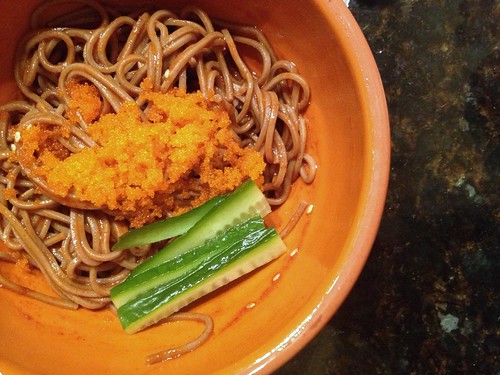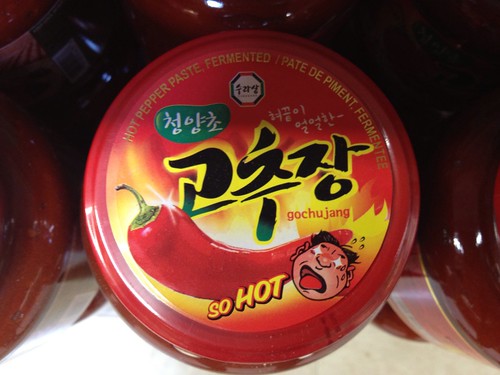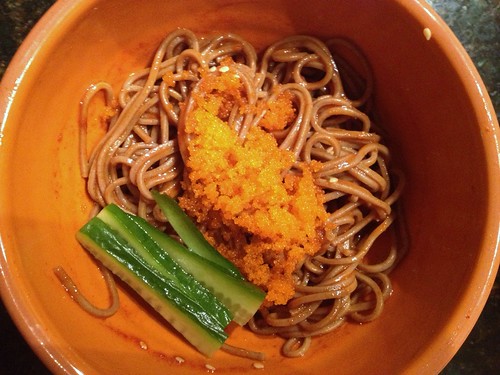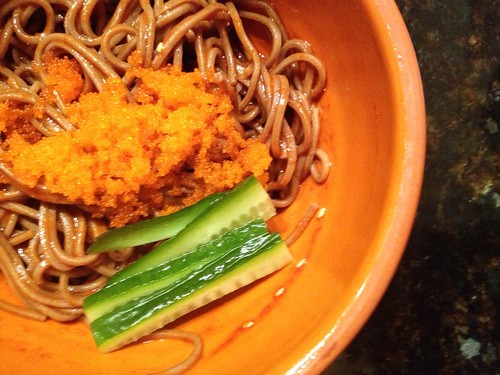
Unless this is your very first visit to the blog, you know we are spicy food eaters. I'm pretty sure sriracha has replaced ketchup in my regular diet (yes, it's all I put on my hot dogs), and the Monkey Scientist believes salt and pepper means salt and crushed red pepper flakes. When the roommate and I were at HMart, the women handing out samples warned us a few times that we should be careful because whatever they were giving us was very spicy. We disagreed.
I say all of this as a warning. This dish was barely more than spaghetti and marinara sauce in our house, but our house is clearly not the norm. If you hate spicy food switch on over to this post. And just ignore all that crushed red pepper....

One thing I love about Asian foods is the variety and intensity of the spiciness they offer. Korean foods in particular have great flavor even in the spiciest ingredients. Whenever we go to the Asian market, we have to pick up a container of gochujang. This time, I learned something new about gochujang! It is rated in terms of spice where the higher number is spicier. Gochujang rated 1-2 is mild, 3 is medium, 4 is hot, and 5 is "burn your face off" hot. Or at least I think that's what this label was trying to tell me. We picked up a 3 and a 5 (the latter for the Monkey Scientist, of course). We don't actually buy this brand, despite their amazing graphic design. We buy Sunchang because the woman at HMart told us it's the best (and some others seem to agree).

I liked this dish because I thought it would be a good way to test out the difference between the gochujang rated a 3 vs the 5. Honestly, I was terrified of the 5 at first. The picture on the jar doesn't have eyes anymore! But it actually wasn't that bad. At first, I don't think there is even a difference between the 3 and 5, but once it hits your mouth the 5 does create a tingle. I definitely burns a little bit, but it's also sort of just like a really pungent half sour pickle. For every day, the 3 is just fine, but I'm ok with keeping the 5 in the house as well.
The dish itself is...interesting. Which I know was what my great grandmother said about things she didn't like, but that's not what I mean at all. I wouldn't say it was my favorite thing I've made recently, but it was a nice change of pace to what we usually eat and was super simple to throw together. It's a cold noodle dish, which I'm not very accustomed to making. I like the cold of the noodles contrasted with the heat from the gochujang. The tobiko on top added a nice bite that I enjoyed a lot. The original recipe was served with a hard boiled egg, but that did not sound up my alley at all. Otherwise, the recipe itself was very good!

BiBim Nengmyun (Gochujang Buckwheat Noodles)
slightly adapted from spoon fork bacon
Ingredients
8 ounces Korean-style buckwheat noodles
1/3 cup gochujang
2 tablespoons granulated sugar
1 ½ tablespoon low sodium soy sauce or tamari
1 tablespoon rice wine vinegar
2 teaspoons sesame oil
1 teaspoon toasted sesame seeds
garnish:
1 tbsp tobiko (flying fish roe)
¼ small hothouse cucumber, julienne
Instructions
1. Cook the buckwheat noodles according to package instructions. Rinse in a colander under cold water until the noodles are cool.
2. Combine the gochujang, sugar, soy sauce, rice wine vinegar, sesame oil, and sesame seeds in a small bowl and whisk until smooth. The gochujang will be thick at first, but just keep whisking!
3. Pour the sauce over the noodles and stir to coat. Garnish with tobiko and julienned cucumber.

No comments:
Post a Comment